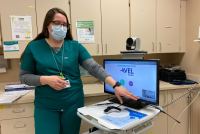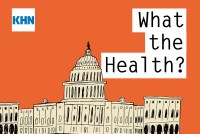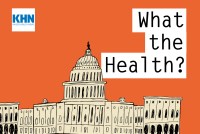Latest KFF Health News Stories
Telehealth Brings Expert Sexual Assault Exams to Rural Patients
Some rural residents must travel hours for a sexual assault exam. Specialized telehealth services are expanding so they can obtain care closer to home.
KHN’s ‘What the Health?’: Finally, a Fix for the ‘Family Glitch’
President Joe Biden welcomed former President Barack Obama back to the White House this week to announce a new policy for the Affordable Care Act that would make subsidies available to more families with unaffordable employer coverage. Meanwhile, Congress struggled to find a compromise for continued federal funding of covid-19 vaccines, testing, and treatments. Tami Luhby of CNN, Shefali Luthra of The 19th, and Jessie Hellmann of CQ Roll Call join KHN’s Julie Rovner to discuss these issues and more.
Money Flows Into Addiction Tech, But Will It Curb Soaring Opioid Overdose Deaths?
Experts are concerned that flashy Silicon Valley technology won’t reach those most in need of treatment for substance use disorders.
Pandemic Medical Innovations Leave Behind People With Disabilities
As the country enters Year 3 of the pandemic emergency, people with disabilities across the U.S. are still finding it difficult to use innovations in telemedicine, teleworking, and testing.
‘The Charges Seem Crazy’: Hospitals Impose a ‘Facility Fee’ — For a Video Visit
Facility fees, designed to help hospitals cover the high cost of staying open 24/7, have long rankled consumers. Now, some patients are assessed the fees while sitting at home for a telehealth appointment.
Post-Pandemic, What’s a Phone Call From Your Physician Worth?
Medicare billing codes for audio-only follow-up check-ins lead to new reimbursement battles.
Texas Toughens Ban on Medication-by-Mail Abortions With Jail Time and Hefty Fine
Last week, on the same day the Supreme Court heard a case that could overturn Roe v. Wade, the landmark ruling on abortion rights, Texas enacted a law that creates criminal penalties for anyone who prescribes medication abortions via telehealth or mail.
KHN’s ‘What the Health?’: Why Health Care Is So Expensive, Chapter $22K
Congress is making slow progress toward completing its ambitious social spending bill, although its Thanksgiving deadline looks optimistic. Meanwhile, a new survey finds the average cost of an employer-provided family plan has risen to more than $22,000. That’s about the cost of a new Toyota Corolla. Alice Miranda Ollstein of Politico, Anna Edney of Bloomberg News and Rebecca Adams of CQ Roll Call join KHN’s Julie Rovner to discuss these issues and more. Also this week, Rovner interviews Rebecca Love, a nurse academic and entrepreneur, about the impending crisis in nursing.
Muchos empleadores informaron que desde que comenzó la pandemia han realizado cambios en sus beneficios de salud mental y adicciones. La principal forma fue extender el uso de la telemedicina.
As Workers Struggle With Pandemic’s Impact, Employers Expand Mental Health Benefits
Many job-based health plans broadened their mental health and substance use coverage to make sure workers had the support they needed this year as pandemic stress lingered, the annual KFF survey finds. Also, the proportion of employers offering health insurance to their workers remained steady, and increases for premiums and out-of-pocket health expenses were moderate.
KHN’s ‘What the Health?’: Biden Social-Spending ‘Framework’ Pulls Back on Key Health Pledges
President Joe Biden unveiled a compromise “Build Back Better” framework shortly before taking off for key meetings in Europe, but it’s unclear whether the framework can win the votes of all Democrats in the House and Senate, and it leaves out some of the party’s health priorities, notably significant provisions to lower prescription drug prices. Meanwhile, younger children may soon be eligible for covid vaccines. Joanne Kenen of Politico and Johns Hopkins, Sarah Karlin-Smith of the Pink Sheet and Rachana Pradhan of KHN join KHN’s Julie Rovner to discuss these issues and more.
Insurance Focused on Virtual Visits? The Pros and Cons of a New Twist in Health Plans
New, often lower-cost plans capitalize on the convenience of telemedicine — and patients’ growing familiarity with it. But consumers should weigh costs and care options before enrolling in a “virtual-first” plan.
Telemedicine Abortions Offer Cheaper Options but May Also Undermine Critical Clinics
A change in FDA rules during the pandemic has let women receive the drugs needed for a medical abortion by mail after a telemedicine appointment. While some abortion rights advocates hail the move, others note that these services, which are often cheaper than going to a clinic, could siphon away patients needed to keep those brick-and-mortar facilities operating.
Telehealth’s Limits: Battle Over State Lines and Licensing Threatens Patients’ Options
Televisits took off during the worst days of the pandemic, but states are now rolling back the temporary rules that facilitated them. That’s adding fuel to debates about states’ authority over medical licensing.
New Moms Latched On to Remote Breastfeeding Help. Will Demand Wane as Pandemic Fades?
The pandemic forced new parents to find help with breastfeeding online. Now, some offerings are remaining virtual to help expand access to lactation support.
The Pandemic Made Telemedicine an Instant Hit. Patients and Providers Feel the Growing Pains.
Patients seem to like remote visits, and health care providers now depend on them. But outages, freezing and other glitches cost time and money, and compromise quality of care.
Calming Computer Jitters: Help for Seniors Who Aren’t Tech-Savvy
Millions of older adults want to be comfortable going online and using digital tools to enhance their lives. But many need help. A number of groups around the country offer assistance.
Doctor on Call? Lawmakers Debate How Much to Pay for Phone Appointments
Phone visits became an option for many Medicare and Medicaid patients during the pandemic. Now policymakers are deciding whether they’re worth the money.
Covid Was a Tipping Point for Telehealth. If Some Have Their Way, Virtual Visits Are Here to Stay.
Pressure is mounting on Congress and the Biden administration to make permanent pandemic-inspired rules that fueled telehealth growth. Some fear fraud and ballooning costs.
Doctors Tell How to Make the Most of Your Telehealth Visits
Public health restrictions put in place during the pandemic are loosening, meaning it’s OK to go back to your doctor’s office. But will virtual visits remain an option?
























